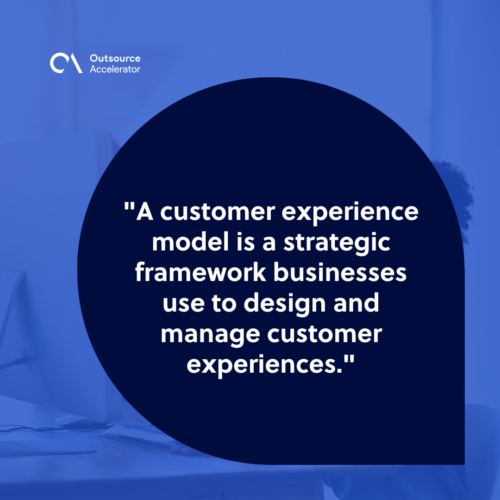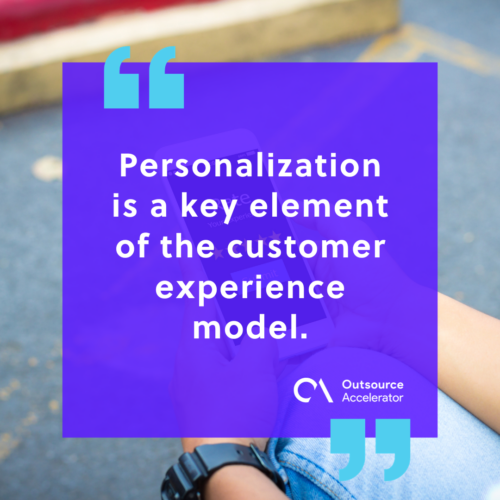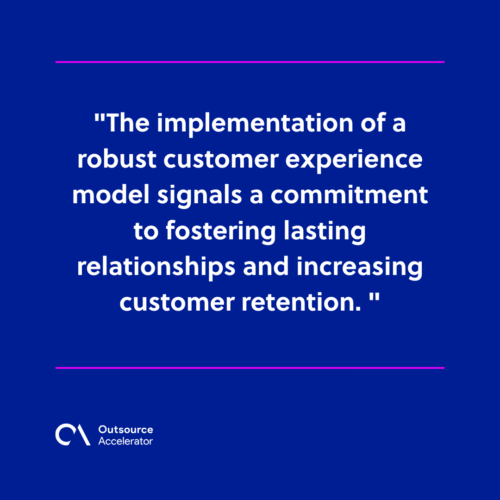What is a customer experience model?

As companies vie for loyalty, the significance of a well-crafted customer experience model cannot be overstated. With consumer expectations at an all-time high, offering a great product or service is no longer sufficient.
This concept goes beyond mere transactions. Companies must focus on creating a customer experience model encompassing every touchpoint and interaction throughout the customer journey.
In this article, we’ll delve into the essential components of an effective customer experience model. We’ll explore how businesses can leverage innovative approaches to meet and exceed customer expectations.
Defining customer experience model
A customer experience model is a strategic framework businesses use to design and manage customer experiences. It includes all the various touchpoints throughout the customer journey.
This model aims to align all aspects of the business to promote customer loyalty, including:
- Branding
- Product offerings
- Pricing
- Customer service
A well-designed customer experience model considers the customer’s perspective. Doing so creates a positive, consistent, and memorable experience that boosts satisfaction.

Why is a customer experience model important?
A customer experience model is important because it directly impacts customer satisfaction.
Customer satisfaction is the overall evaluation or perception that customers have about their interactions with a brand. An effective customer experience model ensures that customers have positive experiences, leading to higher satisfaction and loyalty.
Satisfied customers are more encouraged to continue doing business with you, resulting in increased customer retention and repeat purchases. They’re also more likely to recommend the brand to others.
Meanwhile, a negative customer experience has detrimental effects. It diminishes the perception of your brand and makes people more likely to switch to competitors.
By prioritizing a customer experience model, businesses can deliver valuable moments to customers. This positively impacts your reputation and acts as a foundation for long-term success, growth, and profitability.
Key elements of a customer experience model
A customer experience model typically comprises several key elements that shape and enhance the overall customer journey.
Customer understanding
The foundation of any customer experience model is a deep understanding of the target customers. This involves researching and gathering data to identify their needs, preferences, and expectations.
Knowing who your customers are will enable you to anticipate and address their needs before they become problems. This demonstrates your commitment to their satisfaction.
Customer journey mapping
Understanding and mapping the customer journey from awareness to post-purchase helps identify touchpoints and potential pain points. This enables businesses to enhance each stage of the experience.
Take note of interactions through various channels like:
- Physical stores
- Websites
- Mobile apps
- Call centers
- Social media
Omnichannel presence
A successful customer experience model provides a seamless and dependable experience across all channels. This means ensuring that customers can interact with the brand consistently, regardless of the platform.
Personalization
Personalization is a key element of the customer experience model. By leveraging customer data and insights, businesses can tailor experiences to individual customers’ preferences.
This approach results in a more relevant and engaging interaction, which fosters a stronger sense of connection.

Emotional connection
Great customer experiences go beyond meeting functional needs. They also aim to create emotional connections.
Doing so involves appealing to customers’ emotions by delivering moments that evoke positive feelings like joy, satisfaction, and trust.
Employee engagement
Well-trained and engaged employees play a crucial role in delivering a positive customer experience. A customer experience model should consider how to empower and support employees to provide outstanding service and interactions.
Investing in employee development ensures they understand and embody your brand values to effectively impact experiences.
Improvement and innovation
A customer experience model should incorporate mechanisms for continuous improvement. This includes gathering customer feedback, analyzing metrics, and making iterative changes to refine and enhance the journey.
These improvements can also lead to innovation. Companies should stay abreast of technological advancements and market trends to meet changing customer expectations.
10 tips for creating a customer experience model
Here are some tips that you can use to create a unique customer experience model:
- Start with empathy. Cultivate empathy throughout your organization to truly understand your customers’ needs, emotions, and pain points. Empathy serves as the foundation for experiences that genuinely resonate.
- Implement surprise and delight tactics. Integrate elements like unexpected gestures, personalized gifts, or exclusive access to events or content.
- Foster co-creation. Involve customers in the creation process by seeking their input, feedback, and ideas. This collaboration ensures that the customer experience model aligns with their preferences.
- Incorporate social responsibility. This could involve partnering with nonprofits, supporting causes, or implementing sustainable practices that resonate with customer values.
- Introduce gamification. Integrate game-like elements into the customer journey to enhance engagement and make the experience more enjoyable.
- Create a community ecosystem. Foster a sense of community among your customers by providing them with platforms to connect and share experiences.
- Enable self-service options. Empower customers with self-service options that allow them to find information, troubleshoot issues, or make purchases independently.
- Provide educational resources. Offer valuable educational content that helps customers make informed decisions and positions your brand as an authority in your industry.
- Incorporate multisensory experiences. Appeal to multiple senses by designing experiences that engage sight, sound, touch, and even smell. Create a more immersive and memorable customer experience model.
- Invest in employee well-being. Recognize the impact of employee well-being on the customer experience. Content and driven employees are more likely to provide outstanding customer service.
You can create a distinctive and memorable brand identity by incorporating these tips into your customer experience model. With luck, this will resonate with customers and foster loyalty, setting your business apart from the competition.
Increase retention with a customer experience model
The implementation of a robust customer experience model signals a commitment to fostering lasting relationships and increasing customer retention.

Businesses can create positive impressions that resonate long after the initial transaction by prioritizing a seamless and personalized journey. They align their practices with customer needs and pave the way for loyalty and advocacy.
By investing in a customer experience model, you invest in your own longevity. You’ll build a foundation for enduring customer relationships that withstand the test of time and competition.







 Independent
Independent




